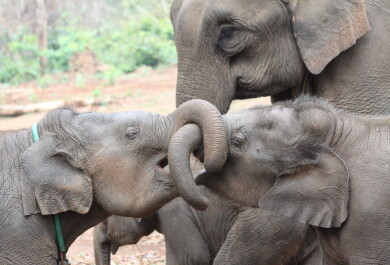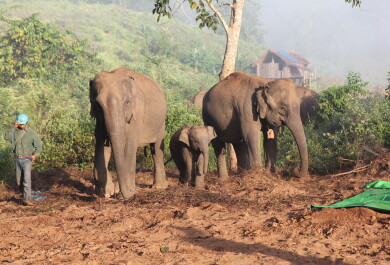In two new studies, scientists from the University of Turku, Finland, have investigated how to measure stress in semi-captive working elephants. The studies suggest that both physiological and behavioural approaches can be used to reliably assess the wellbeing of semi-captive Asian elephants.
Across the world, animals are kept in captivity for various reasons: in zoos for education and research, in research facilities for testing, on farms for meat and other products, and in people’s homes as pets. Maintaining good animal welfare is not only important for ethical reasons; poor welfare can impact human wellbeing and the economy. But how do we assess how animals are feeling?
One way to assess animal wellbeing is to look at stress levels. Vets typically use two biological measures of stress: stress hormone levels and white blood cell ratios. In mammals – including humans – the most important stress hormone is cortisol. When animals are faced with danger, cortisol is produced to help prepare the body for a challenge. However, if high stress and cortisol are experienced constantly, they can impact an animal’s health.
In addition to cortisol, scientists can also look at the ratio of two types of white blood cells, heterophils (or neutrophils) and lymphocytes. These cells play an important role in the immune system of mammals, and after animals have experienced a stressful event, their ratio is typically high.
Researchers at the University of Turku, Finland, wanted to find out if these two biological measures of stress were correlated and whether animals with high levels of cortisol also had a high heterophil to lymphocyte ratio. They measured cortisol and heterophil to lymphocyte ratios in 120 Asian elephants from a semi-captive population of working timber elephants in Myanmar. The researchers also weighed each elephant, as body weight is a good indicator of general health.
– Some previous studies have found a positive relationship between stress hormones and heterophil to lymphocyte ratios, while others have found no relationship at all. It was also unclear from previous studies whether these two measures of stress are comparable across individuals of different sex and age, as well as across the seasons. In this population, we found that elephants with higher levels of the stress hormone cortisol also had higher ratios of heterophils to lymphocytes. This was true regardless of sex and age, says Postdoctoral Researcher and the lead author on the first study, Martin Seltmann, from the Department of Biology at the University of Turku.
An additional aim of the study was to test if stress hormones and heterophil to lymphocyte ratios are related to body weight in Asian elephants.
- We did not find a link between the white blood cell ratios and body weight, but elephants with higher levels of stress hormone had a lower body weight, indicating that elevated stress is linked to weight loss. It is useful to see that both a biological marker (cortisol) and physical indicator (body weight) of welfare respond in the same way. This means that both markers can be used to assess the wellbeing of elephants, says researcher Susanna Ukonaho, who participated in the study.
Non-experts Can Identify Stress Behaviour
In the second study, the researchers investigated whether welfare can also be reliably assessed by observing an animal’s behaviour. While elephant specialists may be able to quickly identify behavioural changes, expert knowledge is not always available, so the researchers wanted to test the reliability of behavioural assessments by non-experts. First, they filmed over 100 working Asian elephants undertaking tasks that were either familiar or new to them.
– The elephants were asked to pick up different types of objects, including objects they had never seen before. This included items such as a plastic bottle, which some elephants were clearly unsure about, says the lead author on the study, Jonathan Webb.
The researchers constructed a list of elephant behaviours, which was then used by three volunteers with no prior experience of Asian elephants to collect behavioural data from the films.
To assess the reliability of the behavioural data, the researchers looked at how similar the observers’ scores were for each film. They also assessed observer consistency by getting the volunteers to score films twice. They found that all three volunteers consistently and reliably identified many elephant behaviours, indicating that even with limited experience, people can reliably monitor elephant behaviour in a way which could improve the quality and safety of working elephant-human relationships.
Behavioural markers could therefore be a simple but useful tool for elephant welfare assessment on a larger scale, although the researchers caution that we still need to know how different behaviours are linked to biological measures of stress.
The relationship between different measures of animal welfare is often complex, but the findings of these two studies show that, at least when working with elephants, caretakers have several options for assessing the wellbeing of their animals. These options will not only facilitate the caretakers’ work, but also help elephants to live better and healthier lives.
The studies were published in the special issue “Captive Elephant Welfare and Behaviour” in the Open Access journal Animals.
> Faecal Glucocorticoid Metabolites and H/L Ratio Are Related Markers of Stress in Semi-Captive Asian Timber Elephants
> Evaluating the Reliability of Non-Specialist Observers in the Behavioural Assessment of Semi-Captive Asian Elephant Welfare
More information
Postdoctoral Researcher Martin Seltmann, tel. +358 2 9450 4259, martin.seltmann@utu.fi
Doctoral Candidate Susanna Ukonaho, tel. +358 2 9450 4261, susanna.s.ukonaho@utu.fi
Doctoral Candidate Jonathan Webb, tel. +64 021 206 1811, jonathan.wb@outlook.com




